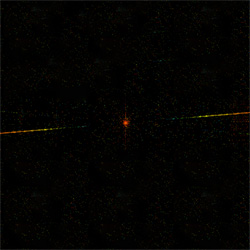Star's Corona Observed with Unprecedented Clarity
August 30, 1999
CXC PR: 99-03
Cambridge, MA--NASA's Chandra X-ray Observatory opened a new era in astronomy Saturday, August 28, by making the most precise measurements ever recorded of the energy output from the 10 million degree corona of a star. Last weekend's observations came after the successful activation of an instrument developed by MIT that will allow a one-thousand-fold improvement in the capability to measure X-ray spectra from space.
The new measurements, made with the High Energy Transmission Grating Spectrometer, join spectacular images taken last week by Chandra of the aftermath of a gigantic stellar explosion. The spectrometer is one of four key instruments aboard Chandra, and the second to be activated. The others will be turned on over the next two weeks.
The spectrometer activated yesterday spreads the X-rays from Chandra's mirrors into a spectrum, much as a prism spreads light into its colors. The spectrum then can be read by Chandra's imaging detectors like a kind of cosmic bar code from which scientists can deduce the chemical composition and temperature of the corona. A corona is a region of hot gas and magnetic loops that extend hundreds of thousands of miles above the star's visible surface and is best studied with X-rays.
"The success of the new spectrometer is definitely a major milestone for modern astronomy," said MIT Professor Claude R. Canizares, principal investigator for the instrument and associate director of the Chandra X-ray Observatory Center (CXC). "Within the first hour we had obtained the best X-ray spectrum ever recorded for a celestial source. We can already see unexpected features that will teach us new things about stars and about matter at high temperatures."
The spectrometer measured X-rays from the star Capella, which is 40 light years away in the constellation Auriga. Capella is actually two stars orbiting one another and possibly interacting in ways that pump extra heat into the corona, which appears more active than that of the Sun. How a star manages to heat its corona to temperatures a thousand times higher than its own surface is still a puzzle, which astronomers hope can be solved by observations like this one. Other prime targets for Chandra's spectrometers over the next few months include black holes, quasars and supernova explosions.
The grating spectrometer consists of hundreds of gold gratings, each about the size of a postage stamp. The surface of each grating resembles a precise picket fence, with microscopic gold pickets 500 times thinner than a human hair. These are spaced every 2000 angstroms, or less than half the wavelength of visible light. The instrument was developed at MIT's Center for Space Research, which Professor Canizares directs, by adapting techniques usually used to make computer chips. Some of these adaptations have found their way back as improvements in the chip-making industry.
The grating spectrometer is one of two such devices carried by Chandra. The other, a low-energy grating built by a Dutch-German team, will be activated next week. Chandra also contains two detectors. One, built by researchers at Pennsylvania State University and MIT, was turned on two weeks ago and has recorded all the images and spectra seen so far. The second, built by the Smithsonian Astrophysical Observatory, is being activated this week.
Dr. Stephen Murray of the Harvard-Smithsonian Center for Astrophysics summarized the expected impact of Chandra's high resolution X-ray spectroscopy with these words: "A picture is worth a thousand words, a spectrum is worth a million."
Capella's spectrum and further information about Chandra's High Energy Transmission Grating Spectrometer may be found at: http://space.mit.edu/about/history
The Chandra X-ray Observatory Center was named in honor of the late Nobel laureate Subrahmanyan Chandrasekhar. NASA's Marshall Space Flight Center manages the Chandra program. TRW, Inc., Redondo Beach, CA, is the prime contractor for the spacecraft. The Smithsonian Astrophysical Observatory's Chandra X-ray Center controls science and flight operations from Cambridge, MA. The first Chandra images and more information on the Chandra X-ray Observatory Center are available at:
NASA TV on the web
MEDIA CONTACTS
Contact:
Elizabeth Thomson
Massachusetts Institute of Technology News Office
Phone: 617-258-5402
Dr. Wallace Tucker
Chandra X-ray Observatory Center,
Harvard-Smithsonian Center for Astrophysics
Phone: 617/496-7998



